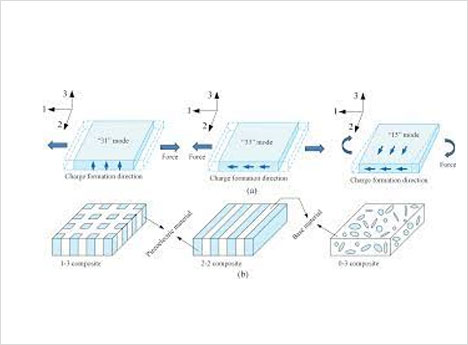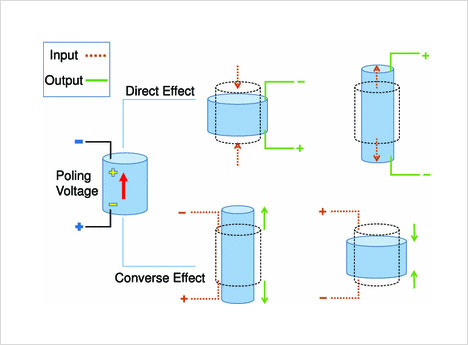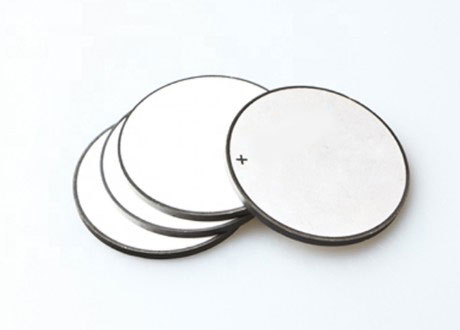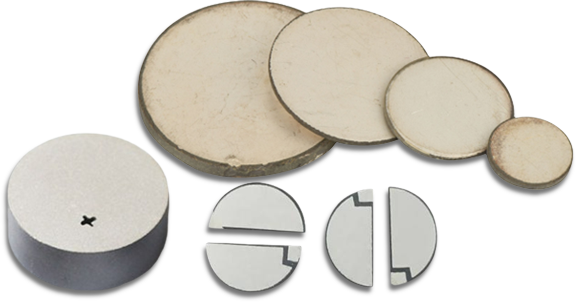What is Piezoelectric Ceramic Discs?
Piezoelectric ceramics are made by using the relative displacement of the internal positive and negative charge centers caused by the mechanical stress of the materials, resulting in the binding charges with opposite signs on the surfaces at both ends of the materials, i.e. piezoelectric effect. They have sensitive characteristics.
Piezoelectric ceramics are made by using the relative displacement of the internal positive and negative charge centers caused by the mechanical stress of the materials, resulting in the binding charges with opposite signs on the surfaces at both ends of the materials, i.e. piezoelectric effect. They have sensitive characteristics.
Piezoelectric ceramics are mainly used to manufacture ultrasonic transducers, underwater acoustic transducers, electro acoustic transducers, ceramic filters, ceramic transformers, ceramic frequency discriminators, high-voltage generators, infrared detectors In addition to being used in the high-tech field, surface acoustic wave devices, electro-optic devices, ignition devices and piezoelectric gyroscopes are more used to serve people in daily life and create a better life for people.
Physical Mechanism of Piezoelectric Properties
Bound charge will appear at both ends of the polarized piezoelectric ceramic sheet, so a layer of free charge from the outside is adsorbed on the electrode surface. When an external pressure f is applied to the ceramic sheet, discharge occurs at both ends of the sheet. On the contrary, the charging phenomenon occurs when the tension is applied. This phenomenon of mechanical effect changing into electrical effect belongs to positive piezoelectric effect.
In addition, piezoelectric ceramics have the property of spontaneous polarization, and spontaneous polarization can change under the action of external electric field. Therefore, when an external electric field is applied to a piezoelectric dielectric, changes as shown in the figure will occur and the piezoelectric ceramic will be deformed. However, the reason why piezoelectric ceramics deform is that when the same external electric field as the spontaneous polarization is applied, the polarization intensity is increased. The increase of the polarization intensity makes the piezoelectric ceramic sheet elongate in the polarization direction. On the contrary, if a reverse electric field is applied, the ceramic sheet shortens in the polarization direction. The phenomenon that the electrical effect is transformed into the mechanical effect is the inverse piezoelectric effect.

Piezoelectric materials for sustainable building structures

Springer Piezoelectric devices for ocean energy
Manufacturing Process of Piezoelectric Discs
The process flow chart is as follows- Batching

- Mixing and Grinding

- Pre Firing

- Secondary Grinding

- Granulation

- Molding

- Plastic Discharge

- Sintering Into Porcelain

- Shape Processing

- Electrode

- High Voltage Polarization

- Aging Test
1) Ingredients: carry out pretreatment, remove impurities and moisture, and then weigh various raw materials according to the formula proportion. Note that a small amount of additives should be placed in the middle of the bulk.
2) Mixing and grinding: the purpose is to mix and grind all kinds of raw materials to prepare conditions for complete solid-phase reaction Dry grinding or wet grinding is generally adopted. Dry grinding can be adopted for small batch, and stirring ball milling or air flow grinding can be adopted for large batch, with high efficiency.
3) Pre firing: the purpose is to synthesize piezoelectric ceramics by solid-state reaction of various raw materials at high temperature. This process is very important. It will directly affect the sintering conditions and the performance of the final product.
4) Secondary fine grinding: the purpose is to finely vibrate, mix and grind the pre fired piezoelectric ceramic powder, so as to lay a good foundation for uniform performance of porcelain.
5) Granulation: the purpose is to form particles with high density and good fluidity. The method can be carried out manually, but the efficiency is low. The efficient method is spray granulation. The adhesive is added in this process.
6) Molding: the purpose is to press the prepared granules into the required preform size.
7) Plastic discharge: the purpose is to remove the adhesive added during granulation from the blank.
8) Sintering into porcelain: the blank is sealed and sintered into porcelain at high temperature. This link is very important.
9) Outline processing: grinding the burned products to the required finished product size.
10) Target electrode: the conductive electrode is arranged on the required ceramic surface. The general methods include silver layer sintering, chemical deposition and vacuum coating.
11) High voltage polarization: the electric domains in the ceramic are oriented and arranged, so that the ceramic has piezoelectric properties.
12) Aging test: after the ceramic performance is stable, check all indicators to see whether the expected performance requirements are met.
The manufacturing characteristic of piezoelectric ceramics is to polarize ferroelectric ceramics in a DC electric field to make them have piezoelectric effect. The general polarization electric field is 3-5kv / mm, the temperature is 100-150 ° C, and the time is 5-20min. These three factors are the main factors affecting the polarization effect. The electromechanical coupling coefficient of piezoelectric ceramics with good performance, such as lead zirconate titanate ceramics, can be as high as 0.313-0.694.
Common Use
How to Check the Quality of Piezoelectric Ceramics

Piezoelectric ceramics are functional materials that convert electrical energy into displacement or output. This new material has excellent functionality and is widely used in precision positioning, semiconductor processing, microscopic.
Piezoelectric ceramics are also used in various fields such as imaging and in various fields of life. So, what issues should be considered when selecting piezoelectric ceramics to determine the pressure.
Whether electric ceramics are suitable for use, points and directions to consider when purchasing piezoelectric ceramic materials. Its quality is tested as follows:
For any applications or questions not listed above, please feel free to contact us:
 Contact Us >
Contact Us >
1) Turn the range switch of the multimeter to the DC voltage 2.5V block, gently pinch the two sides of the piezoelectric ceramic sheet with the thumb and index finger of the left hand, and hold the test pen of the multimeter and the red test pen in the right hand.Connect the metal sheet, put theblack test pen on the ceramic surface, then press the left hand slightly, and then loosen it, so that two voltage signals with opposite polari ties are generated on the piezoelectric ceramic sheet.Number, make the pointer of the multimeter swing to the right first, then return to zero, and then swing to the left, the swing is about 0.--0.5V, the larger the swing, the higher the sensitivity. If the multimeter pointer is static If it does not stop, it means the internal leakage or damage.
Remember not to use wet hands to squeeze the piezoelectric film, and the multimeter should not use the AC voltage block during the test, other wise the pointer swing will not be observed, and the Rx10k block is used before the test to measure its insulation voltage.The resistance should be infinite.
2) Use the Rx 10k block to measure the two-pole resistance, which should be ∞ in normal conditions, and then tap the piezoelectric ceramic piece lightly, and the pointer should swing slightly.
Piezoelectric Ceramics Applications
-
LoT / 5G

- ・Antenna adjustment
- ・Anti-shake
- ・Acoustic speaker
- ・Pressure sensor etc.
-
Semiconductor

- ・Mass flow controller
- ・Valve controller
- ・Dispenser controller
- ・Wafer polishing
- ・Wafer polishing
-
Science / Medical

- ・Optical axis (lens) adjustment
- ・Precision stage etc.
-
Ecology / Energy

- ・Piezoelectric power
generation device etc.
- ・Piezoelectric power
-
Mobility

- ・Pressure sensor
- ・Fuel injector etc.
- Batching

- Home
- Product
- Acoustic Component
- Security & Alarm
- Sensor
- Piezo Ceramic
- Connector & Cable
- Fuse & Circuit Breaker
- Switch & Indicator
- Battery Holder & Connectors
- Motors & Fans & Heat Sink
- Power Supply
- Relay & Socket
- Ultrasonic Machine & Part
- LED & LED Display
- Wifi & Antennas
- Inductor & Choke
- Electricians Tools
- Electronic Beauty Instrument
- IC & Semiconductors
- Mould & Plastic Enclosure
- Smart Home
- Arduino & Robot
- Solution
- About
- News
- Contact
- Acoustic Component
- Piezo Ceramic Element
- Piezo Buzzer
- Magnetic Buzzer
- SMD Buzzer
- Piezo Transducer
- Magnetic Transducer
- Mechanical Buzzer
- Electret Condenser Microphone
- Loud Speaker
- Micro Speaker
- Mylar Speaker
- Ultrasonic Speaker
- Headphones & Earbuds & Headsets
- Bluetooth speaker
- Ceiling Speaker
- Garden Speaker
- Party Speaker
- Sound Button
- Sound Module
- Receiver
- Security & Alarm
- Sensor
- Piezo Ceramic
- Connector & Cable
- USB & Type C & HDMI Connector
- FFC / FPC / Wafer connector
- Card Socket
- Water Proof Connector
- Anderson Battery Connector
- Wire Harness
- Micro D Connector
- Coaxial Connectors
- New Energy Vehicle Charge Accessory
- Magnetic Power Connector
- Compact Splicing Connector
- Screw Nut & Spacer
- USB HUB & Type C Adapter Converter
- Splitter & DP HDMI
- Heat Shrink Tube
- USB & Type C & HDMI cable
- Pin Header Connector
- Automotive Connectors
- Ethernet Connectors
- More Products
- Fuse & Circuit Breaker
- Switch & Indicator
- Battery Holder & Connectors
- Motors & Fans & Heat Sink
- Power Supply
- Relay & Socket
- Ultrasonic Machine & Part
- LED & LED Display
- Wifi & Antennas
- Inductor & Choke
- Electricians Tools
- Electronic Beauty Instrument
- IC & Semiconductors
- Mould & Plastic Enclosure
- Smart Home
- Arduino & Robot



